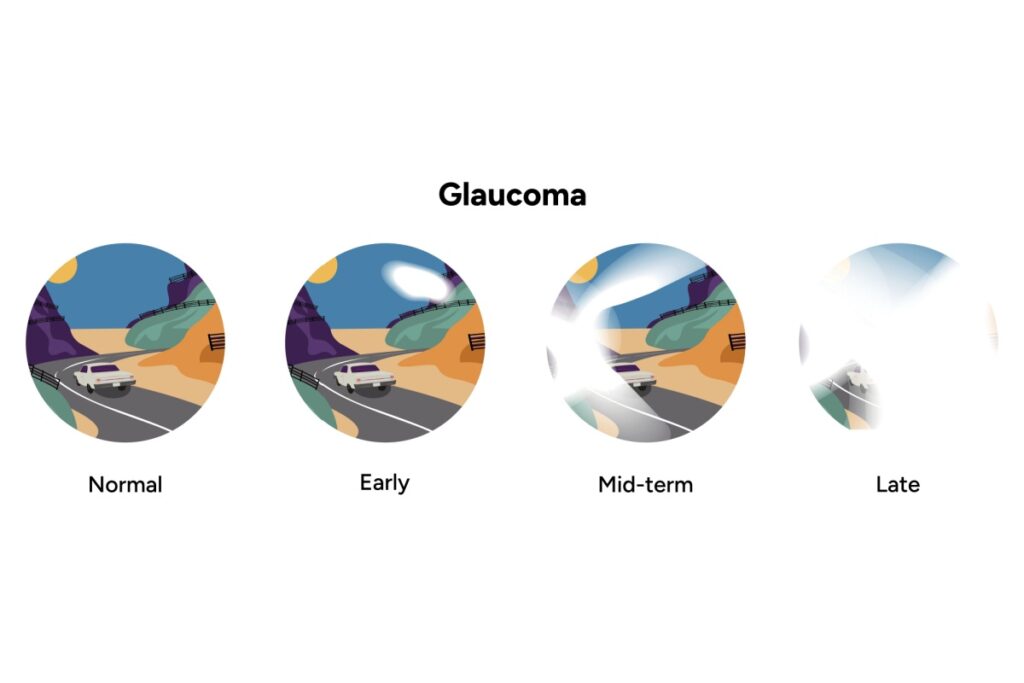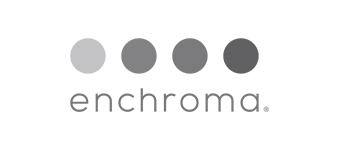Glaucoma is often called the “silent thief of sight” because it can steal your vision gradually without you noticing. This eye condition affects millions of people worldwide and progresses through distinct stages that can span years or even decades. At Brighton Eyecare, we see how early detection through comprehensive eye exams makes all the difference in preserving our patients’ sight.
Glaucoma develops in four main stages — early, moderate, advanced, and severe — with each stage bringing increasing vision loss that cannot be reversed, making early detection through regular eye exams your most powerful tool for preserving sight.
How Glaucoma Develops in Your Eyes
Glaucoma happens when damage occurs to the optic nerve over time, often as a result of pressure building up inside your eye.This nerve carries visual information from your eye to your brain, acting like a cable that connects your eye to your visual processing centre.
The damage occurs gradually, which makes early detection through regular eye exams so important. Many people don’t notice vision changes until the condition has progressed significantly because your brain compensates for small vision losses.
Think of glaucoma like a slow leak in a garden hose, the damage accumulates over months and years before you notice the reduced water pressure. By the time you see symptoms, substantial damage has already occurred. Understanding what glaucoma is and how it affects your vision can help you recognize the importance of preventive care.
Stage 1: Early Glaucoma Signs You Can’t See
In the first stage, glaucoma begins damaging your optic nerve without causing noticeable symptoms. Your central vision remains clear during this phase, and you can still read, drive, and perform all your normal activities.
Small blind spots may start forming in your peripheral vision, but your brain compensates for these gaps automatically. This compensation happens so smoothly that you won’t realize anything has changed.
This stage can last for years, which is why we call glaucoma a silent condition. Regular comprehensive eye exams can detect these early changes long before you notice any vision problems.
What Happens During Early Detection
During your eye exam at our Saskatoon eye care clinic, we can measure the pressure inside your eyes using specialized equipment. We also examine your optic nerve directly to look for signs of damage or changes in its appearance.
Special imaging technology helps us see changes to the nerve fibres that carry your visual signals. These tests can detect glaucoma damage even when your eye pressure appears normal. Advanced tools like optical coherence tomography (OCT) scanning provide detailed images of your retina and optic nerve.
Early detection gives us the opportunity to slow or stop further damage through treatment. Starting care at this stage can help preserve your current vision for years to come.
Stage 2: Moderate Glaucoma & Vision Changes
As glaucoma progresses to the moderate stage, you may start noticing vision problems during daily activities. Blind spots in your peripheral vision become larger and more noticeable, particularly when you’re not focusing directly on them.
You might have difficulty seeing objects to the side while looking straight ahead. Activities like driving or walking in crowded areas may become more challenging as your side vision decreases.
At this stage, family members might notice that you bump into things more often or seem less aware of your surroundings. These changes can happen so gradually that you attribute them to getting older or being distracted.
Common Symptoms at This Stage
- Trouble seeing things in your side vision
- Bumping into objects you didn’t notice
- Difficulty navigating stairs or curbs
- Problems with depth perception
- Challenges judging distances while driving
This is when comprehensive glaucoma testing becomes particularly valuable for monitoring progression and adjusting treatment plans.

Stage 3: Advanced Glaucoma Effects on Daily Life
Advanced glaucoma creates significant vision loss that affects your daily activities in noticeable ways. Large areas of your peripheral vision may be completely gone, creating a tunnel-like effect when you look around.
Your central vision can still remain clear at this stage, but the reduced field of view makes many tasks difficult. Reading may still be possible, but navigation and mobility become more challenging.
You may find yourself turning your head much more frequently to see objects that should be visible in your peripheral vision. Simple tasks like pouring a drink or finding items on a table require more concentration and careful positioning.
How Advanced Stage Impacts You
Walking becomes more cautious as you can’t see potential obstacles, curbs, or steps in your path. You might feel less confident moving through unfamiliar spaces or crowded areas.
Many people at this stage benefit from vision rehabilitation services and adaptive techniques. These programs can help you maintain independence and safety in daily activities through specialized training and tools. Low vision services and resources can provide valuable support during this adjustment period.
Family support becomes more important as you adapt to these vision changes. Simple home modifications like improved lighting and removing tripping hazards can make a significant difference.
Stage 4: Severe Glaucoma & Vision Loss
In the severe stage, glaucoma has caused extensive damage to your optic nerve throughout most of its structure. Both peripheral and central vision may be significantly affected, creating substantial challenges in daily life.
Tasks that require good vision become very difficult or impossible without assistance. This stage represents irreversible vision loss that greatly impacts quality of life and independence.
Even simple activities like recognizing faces, reading large print, or moving safely around your home become challenging. However, most people retain some usable vision even at this advanced stage.
Managing Severe Vision Changes
Even at this stage, continued treatment can help prevent further deterioration of your remaining vision. Every bit of sight you can preserve remains valuable for maintaining some independence.
Low vision aids like magnifying devices, talking watches, and specialized lighting can help you make the most of your remaining vision. Support services through community organizations provide additional resources and training.
Family support and home modifications become important for maintaining safety and independence. Mobility training can help you navigate familiar environments more confidently using your remaining vision and other senses.
Prevention & Early Detection Through Regular Eye Exams
Regular comprehensive eye exams remain your most effective tool for preventing vision loss from glaucoma. These exams can detect changes in your optic nerve and eye pressure before any symptoms appear.
Adults over 40 should have eye exams every year, while those with risk factors may need more frequent visits. Early detection and treatment can slow progression significantly and preserve your sight for many years. Understanding glaucoma testing procedures can help you prepare for your comprehensive exam.
At Brighton Eyecare, we use advanced diagnostic equipment to monitor your eye health and catch glaucoma in its earliest stages. Our comprehensive approach includes pressure testing, optic nerve evaluation, and visual field testing to get a complete picture of your eye health.
What to Expect During Your Glaucoma Screening
Your eye exam includes measuring eye pressure using a comfortable, painless test that takes just seconds. We also examine your optic nerve directly and may take specialized photographs to document its current condition.
Visual field testing maps your peripheral vision to detect any blind spots that may have developed. These tests are comfortable and provide important information about your eye health that we can track over time. Perimetry testing for glaucoma plays a crucial role in monitoring your peripheral vision changes.
If we detect signs of glaucoma, we can discuss treatment options that fit your specific situation and lifestyle. Regular monitoring helps us track any changes and adjust treatment as needed to preserve your vision.
Don’t wait until you notice vision changes to schedule your comprehensive eye exam. Contact our team at Brighton Eyecare today to book your appointment and take the first step in protecting your sight from glaucoma’s silent progression.









